MG Windsor EV versus Tata Nexon EV: Which Ride Should Be Your Next 2024 Green Ride? – Looking for your next eco-friendly vehicle? The MG Windsor EV and Tata Nexon EV are two top contenders for the 2024 electric SUV market. Both vehicles bring cutting-edge technology, impressive battery performance, and the promise of a green future. But which one is the best fit for your driving needs? Dive into the details of these two electric vehicles to explore their origins, specifications, and unique features. Whether you’re looking for a premium experience or a budget-friendly electric ride, this comprehensive guide will help you decide which EV should be your next 2024 green ride.
Table of Contents
Introduction
As the global shift towards electric vehicles (EVs) gains momentum, 2024 introduces two strong contenders in the compact electric SUV segment: the MG Windsor EV and the Tata Nexon EV. Both vehicles offer environmentally conscious drivers a chance to experience powerful, efficient, and tech-laden electric mobility. These EVs stand out for their unique blend of sustainability, advanced features, and high performance, making them top choices for modern drivers seeking eco-friendly alternatives.
The MG Windsor EV is crafted with a focus on providing a luxurious driving experience, featuring state-of-the-art technology and superior comfort. With a sleek design and attention to detail, this EV is tailored for those who prioritize not just functionality but also a premium feel. It is equipped with a single, robust battery pack that delivers a well-balanced range suitable for daily commutes and moderate trips, making it a reliable companion for urban dwellers.
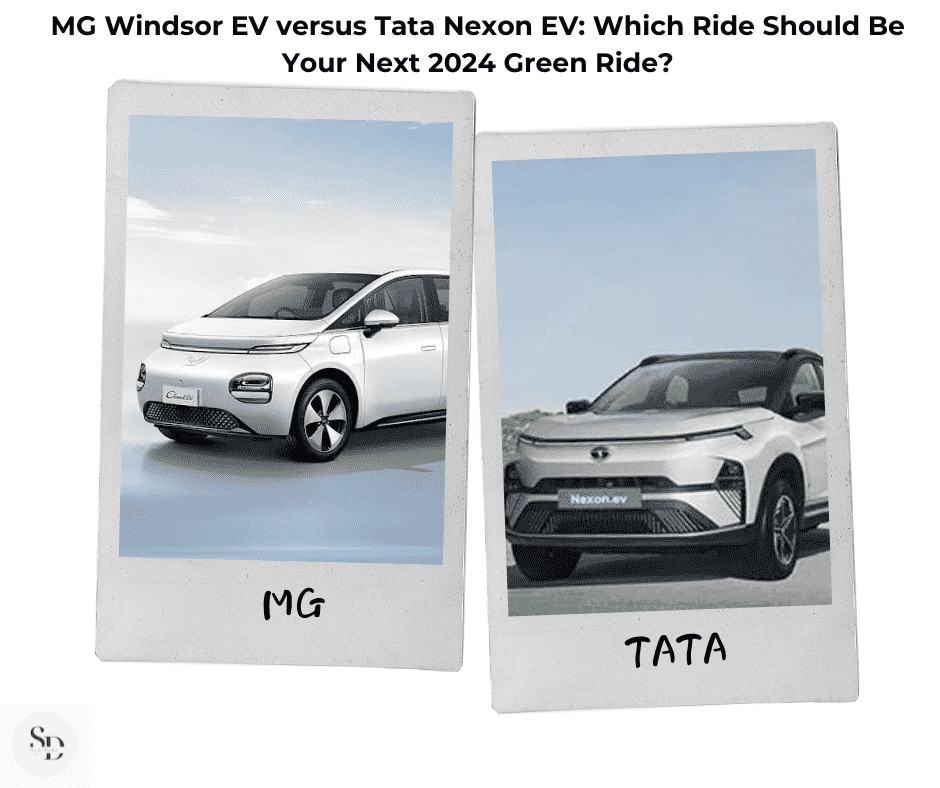
Meanwhile, the Tata Nexon EV represents a more versatile option, offering multiple battery configurations that cater to both city drivers and those needing longer range capabilities. Its value-for-money proposition, combined with the reliability and wide availability of Tata Motors’ service network, makes it one of the most popular electric vehicles in India. This EV packs a punch when it comes to features, all while maintaining a more budget-friendly price point compared to premium electric SUVs.
Both vehicles offer impressive electric driving ranges, enhanced safety features, and cutting-edge infotainment systems, appealing to both first-time EV buyers and seasoned electric vehicle enthusiasts.
Origin
Tata Nexon EV
The Tata Nexon EV emerged from Tata Motors’ vision to revolutionize India’s electric vehicle market. First introduced in 2020, it quickly became one of the country’s most popular electric SUVs, largely due to its affordability and performance. Over the years, Tata Motors has fine-tuned the Nexon EV, enhancing its battery capacity, range, and safety features in response to consumer demand. The 2024 model is a testament to Tata’s continued commitment to providing sustainable and reliable electric vehicles that cater to a broad spectrum of Indian consumers.
MG Windsor EV
The MG Windsor EV is part of MG Motor’s growing EV portfolio, crafted to cater to customers who seek a more refined, luxury-oriented driving experience. MG, originally a British brand, was rejuvenated under the ownership of China’s SAIC Motor Corporation, allowing it to leverage advanced electric technology and modern automotive design. The Windsor EV builds on MG’s history of delivering quality vehicles, incorporating innovations in battery technology, safety, and in-car entertainment. As a 2024 model, the Windsor EV is designed to cater to a global audience, blending European styling with cutting-edge Chinese EV advancements.
Comparison of the MG Windsor EV and the Tata Nexon EV based on various factors
1. Battery and Range
The battery is the heart of an electric vehicle, and both the MG Windsor EV and Tata Nexon EV bring strong offerings to the table.
Tata Nexon EV: Tata Nexon EV offers two battery options – a 30.2 kWh battery for the medium-range (MR) variant and a 40.5 kWh battery for the long-range (LR) variant. The MR variant provides a range of 325 km, while the LR variant offers up to 465 km. This gives the Tata Nexon EV an edge for those who prioritize flexibility, allowing users to select a variant based on their driving requirements-short urban commutes or long-distance travel.
MG Windsor EV: The MG Windsor EV is equipped with a 38 kWh battery, which delivers an estimated range of 331 km. While it sits between the Nexon’s two variants in terms of battery capacity and range, it lacks the flexibility of offering multiple battery configurations like the Nexon EV.
2. Power and Performance
Performance is a key factor when selecting an electric SUV, and both vehicles deliver in different ways.
Tata Nexon EV: The Nexon EV’s MR variant delivers 127 bhp and 245 Nm of torque, while the LR variant bumps this up to 143 bhp with the same torque output. The Nexon EV provides swift acceleration, taking around 9-10 seconds to go from 0 to 100 km/h. With its instant torque delivery, the Tata Nexon EV offers a punchy driving experience, especially in city traffic and on highways.
MG Windsor EV: The MG Windsor EV, with its 134 bhp and 260 Nm of torque, also offers strong performance. It has slightly more torque than the Nexon EV, which results in a similarly responsive and engaging drive. The MG Windsor EV is also capable of achieving 0-100 km/h in around 9 seconds, making it a fast, efficient option in the electric SUV category.
3. Charging Infrastructure and Times
Charging infrastructure and the time it takes to fully recharge an electric vehicle are key considerations.
Tata Nexon EV: Tata Nexon EV supports fast charging, allowing the vehicle to charge from 0 to 80% in about 56 minutes using a DC fast charger for the LR variant, while home charging (using a regular 15A plug point) takes about 8-9 hours for the MR variant and 10-12 hours for the LR variant. The Nexon EV also benefits from Tata Power’s growing EV charging network across India, which offers added convenience.
MG Windsor EV: The MG Windsor EV also supports DC fast charging, taking around 50 minutes to reach 80% capacity. When charged using a standard AC charger, the charging time is around 7-8 hours. MG has been expanding its charging network through partnerships, but it is still somewhat limited in comparison to Tata’s extensive charging infrastructure in India.
4. Exterior Design and Styling
The design of an SUV plays a major role in attracting buyers, and both the MG Windsor EV and Tata Nexon EV offer distinct aesthetics.
Tata Nexon EV: The Nexon EV carries Tata Motors’ Impact Design 2.0 philosophy, giving it a sporty and robust look. The sharp lines, muscular stance, and aggressive front grille make the Nexon EV stand out in a crowd. The aerodynamic design, along with its stylish LED headlights and signature tri-arrow elements, gives the Nexon EV a modern appeal. The choice of bold colors and dual-tone roof options also adds to its youthful, energetic vibe.
MG Windsor EV: The MG Windsor EV, on the other hand, takes a more sophisticated and premium approach. The Windsor EV features a sleek and flowing design, with smooth curves and a more understated grille. The chrome accents, large LED headlamps, and well-proportioned body give it an elegant yet imposing road presence. The Windsor EV’s design focuses more on a luxury feel, with attention to detail that appeals to buyers looking for a refined, premium aesthetic.
5. Interior Features and Comfort
The cabin experience is crucial for long drives and daily commutes alike, and both vehicles offer their own blend of comfort and technology.
Tata Nexon EV: The interior of the Nexon EV is designed to be both functional and stylish. The cabin features a 7-inch touchscreen infotainment system with Android Auto and Apple CarPlay compatibility. The Nexon EV also comes equipped with automatic climate control, rear AC vents, and a digital instrument cluster. The premium leatherette upholstery, along with ambient lighting and a spacious cabin, makes for a comfortable ride, while the high seating position provides a commanding view of the road.
MG Windsor EV: The MG Windsor EV raises the bar with a 15.6-inch touchscreen infotainment system, offering an immersive experience. The cabin is plush and comes with ventilated seats, electric sunroof, and a premium infinity sound system. The Windsor EV also includes features like wireless charging, ambient lighting, and a customizable digital dashboard, giving it a more luxurious feel. The seats are well-bolstered, providing comfort during long journeys.
6. Infotainment and Connectivity
Infotainment systems in modern cars go beyond music, offering navigation, real-time updates, and connectivity options.
Tata Nexon EV: The Tata Nexon EV features a 7-inch Harman Kardon infotainment system, which is compatible with Android Auto and Apple CarPlay. It also offers connected car technology with Tata’s iRA app, providing vehicle diagnostics, remote control, geofencing, and live location tracking. The 8-speaker system offers decent audio quality, and the infotainment system is user-friendly with crisp display graphics.
MG Windsor EV: The Windsor EV boasts a larger 15.6-inch touchscreen system that supports Android Auto and Apple CarPlay. In addition, the MG i-SMART technology offers connected car features, including remote vehicle control, over-the-air updates, voice commands, and integrated navigation. The Infinity sound system further enhances the audio experience, offering crisp and immersive sound quality.
7. Safety Features
Safety is a non-negotiable aspect for electric vehicles, and both the MG Windsor EV and Tata Nexon EV have packed in plenty of features.
Tata Nexon EV: The Nexon EV is equipped with a robust safety suite that includes 6 airbags, ABS with EBD, ESP, hill hold assist, and a rear parking camera. Additionally, the Nexon EV has a 5-star NCAP safety rating, making it one of the safest electric SUVs in India. The inclusion of features like brake assist, roll-over mitigation, and corner stability control adds to the overall confidence when driving the Nexon EV.
MG Windsor EV: The Windsor EV also comes equipped with 6 airbags, ABS with EBD, traction control, and hill descent control. It includes a 360-degree camera, which provides a complete view of the surroundings, making parking and navigating tight spaces easier. The MG Pilot safety suite offers additional features like adaptive cruise control, lane-keeping assist, and blind-spot detection.
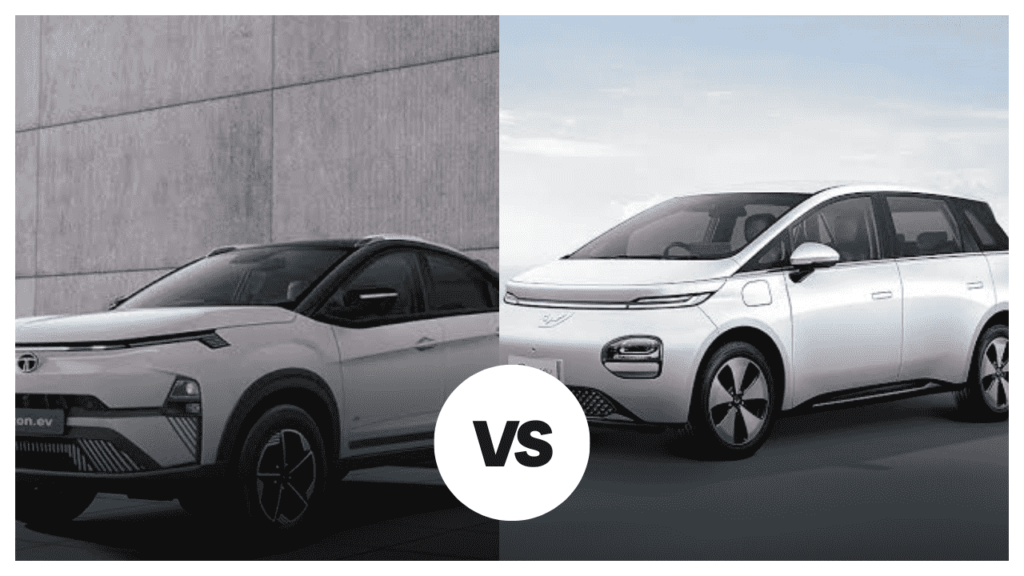
8. Pricing and Value for Money
Price is often a key consideration when choosing an electric vehicle, and both the Tata Nexon EV and MG Windsor EV are positioned at different ends of the EV price spectrum.
The Tata Nexon EV offers great value, especially for buyers seeking an affordable entry into the electric vehicle market. The pricing range of ₹15 lakh to ₹18 lakh makes it one of the more accessible EVs in India, considering its array of features and safety equipment. The long-range variant, while slightly more expensive, still undercuts many competitors in the premium EV space, making it ideal for buyers who prioritize both affordability and range.
On the other hand, the MG Windsor EV is positioned as a more premium offering, with a price tag starting at around ₹16 lakh and going up to ₹24 lakh, depending on the variant and additional features. It justifies its higher price with more advanced technology, a premium interior, and a broader suite of safety features, including ADAS. For buyers looking for a more luxurious and tech-savvy electric vehicle, the MG Windsor EV provides value through its additional features, though it comes at a premium compared to the Nexon EV.
9. Warranty and After-Sales Support
Tata Nexon EV: Tata offers a comprehensive 8-year/1.6 lakh km warranty on the battery and motor, along with a 3-year/1.25 lakh km warranty on the vehicle itself. Tata also provides a growing network of EV service centers and roadside assistance, making it easier for Nexon EV owners to maintain their vehicle over the long term. Tata’s commitment to after-sales support is further strengthened by its Tata Power charging network, which is expanding rapidly across India.
MG Windsor EV: MG also offers a similar 8-year/1.5 lakh km warranty on the battery and motor, with a 3-year/1 lakh km warranty on the vehicle. MG has been expanding its service network in India and offers 24/7 roadside assistance, along with a dedicated service app for seamless customer experience. MG’s EV-specific service centers are fewer in number compared to Tata, but they are steadily growing.
10. Color Options
The aesthetic appeal of a vehicle is influenced by the color choices available, and both the Tata Nexon EV and MG Windsor EV come with a range of attractive options.
Tata Nexon EV: Available in a variety of vibrant and subtle hues, the Nexon EV offers color options like Signature Teal Blue, Glacier White, and Daytona Grey. Tata has also introduced dual-tone variants with contrasting roof colors for added personalization.
MG Windsor EV: The MG Windsor EV comes in premium color choices such as Ferris White, Stellar Black, Dynamic Red, and Moondust Silver, reflecting its more upscale positioning. The colors emphasize the Windsor’s sleek design, catering to customers who prefer a more elegant and sophisticated appearance.
11. Driving Modes and Regenerative Braking
Driving modes and regenerative braking are critical in optimizing energy use and enhancing the driving experience.
Tata Nexon EV: The Nexon EV comes with three driving modes: Eco, City, and Sport. These modes allow the driver to switch between maximizing range (Eco mode), balanced performance (City mode), and dynamic driving (Sport mode). The Nexon EV also features a regenerative braking system, where energy from deceleration is captured and fed back into the battery, thus extending the range. However, the levels of regen are not customizable.
MG Windsor EV: The Windsor EV offers multiple driving modes: Normal, Eco, and Sport, with the additional advantage of adjustable regenerative braking levels. The driver can customize the intensity of the regen based on their driving preferences, which can help boost range in city driving conditions. This feature gives the Windsor EV a slight edge for drivers who want more control over their vehicle’s energy efficiency.
12. Ground Clearance and Off-road Capability
Ground clearance and off-road capabilities are important considerations for SUVs, especially in countries like India, where road conditions can be challenging.
Tata Nexon EV: With a ground clearance of 205 mm, the Nexon EV is well-suited to handle uneven terrain, potholes, and speed bumps commonly found on Indian roads. While not designed for hardcore off-roading, the Nexon EV’s high ground clearance ensures a smooth ride in most urban and semi-rural environments.
MG Windsor EV: The Windsor EV offers a slightly lower ground clearance of 180 mm, making it more suitable for well-paved urban environments. While it can handle typical road imperfections, it may not be as effective on rougher roads or off-road conditions as the Nexon EV.
13. Boot Space and Practicality
Boot space is crucial for families and those who need to carry luggage or goods regularly.
Tata Nexon EV: The Nexon EV offers a 350-liter boot space, which is fairly generous for an electric SUV in its class. The boot design is practical, with wide access and rear seats that can fold down to increase the storage area.
MG Windsor EV: The MG Windsor EV, being a larger and more premium vehicle, offers 400 liters of boot space, making it more suitable for families or long trips where extra luggage is a necessity. It also features a flat loading floor for easier access.
14. Noise, Vibration, and Harshness (NVH) Levels
Electric vehicles are generally quieter than their internal combustion counterparts, but NVH levels can still vary between models.
Tata Nexon EV: The Nexon EV provides a reasonably quiet cabin experience, with minimal road noise at city speeds. However, some users have reported that at higher speeds, road and wind noise becomes more noticeable. The insulation is decent but not exceptional, considering the segment.
MG Windsor EV: The Windsor EV excels in NVH levels, thanks to its premium positioning. It offers superior cabin insulation, keeping road, wind, and even motor noise to a bare minimum. This makes the Windsor EV a more comfortable option for long drives, especially on highways.
15. Environmental Impact and Sustainability
One of the primary reasons for switching to electric vehicles is reducing environmental impact, and both the Nexon EV and Windsor EV contribute significantly to sustainability.
Both vehicles help reduce greenhouse gas emissions by eliminating tailpipe emissions, and their manufacturers are committed to sustainable practices. Tata Motors is working on reducing the carbon footprint across its supply chain and vehicle lifecycle, while MG Motor is focusing on recycling EV batteries and developing sustainable manufacturing processes.
Some other comparison points between the MG Windsor EV and Tata Nexon EV
Resale Value
MG Windsor EV: The resale value of the MG Windsor EV is expected to hold up well due to its luxury positioning and premium features. MG is building a strong presence in the electric vehicle market, and the vehicle’s longer range and advanced technology should contribute positively to its future resale value. However, as it is a higher-priced vehicle, the potential market for resale may be smaller than for more affordable EVs.
Tata Nexon EV: The Tata Nexon EV is expected to have solid resale value, largely due to its popularity and Tata’s established brand reputation in India. As one of the most affordable electric SUVs, the demand for used Tata Nexon EVs is likely to remain strong, especially in the growing EV market. Its affordability and practicality ensure that it remains a desirable option in the second-hand market.
Battery Warranty
MG Windsor EV: Comes with a longer warranty period on the battery, which adds peace of mind for buyers concerned about battery longevity. Typically, the battery is covered for 8 years or 150,000 km.
Tata Nexon EV: Offers a 8-year or 160,000 km warranty on the battery, which is competitive, though the battery capacity is slightly smaller.
Charging Infrastructure
MG Windsor EV: MG is expanding its fast-charging network across India, but it’s not as extensive as Tata’s. However, the Windsor EV supports fast charging, allowing a quick recharge time at compatible stations.
Tata Nexon EV: Tata has invested heavily in setting up fast chargers across the country, offering greater convenience. The Nexon EV supports fast charging, and there are more available locations for Tata owners to recharge.
Build Quality
MG Windsor EV: Known for its robust build quality and use of premium materials. The vehicle feels solid and durable, which adds to its luxury appeal.
Tata Nexon EV: While not as premium as the Windsor EV, the Nexon EV has a sturdy build and is built to handle rough Indian roads. It’s safer and well-suited for both urban and semi-urban driving environments.
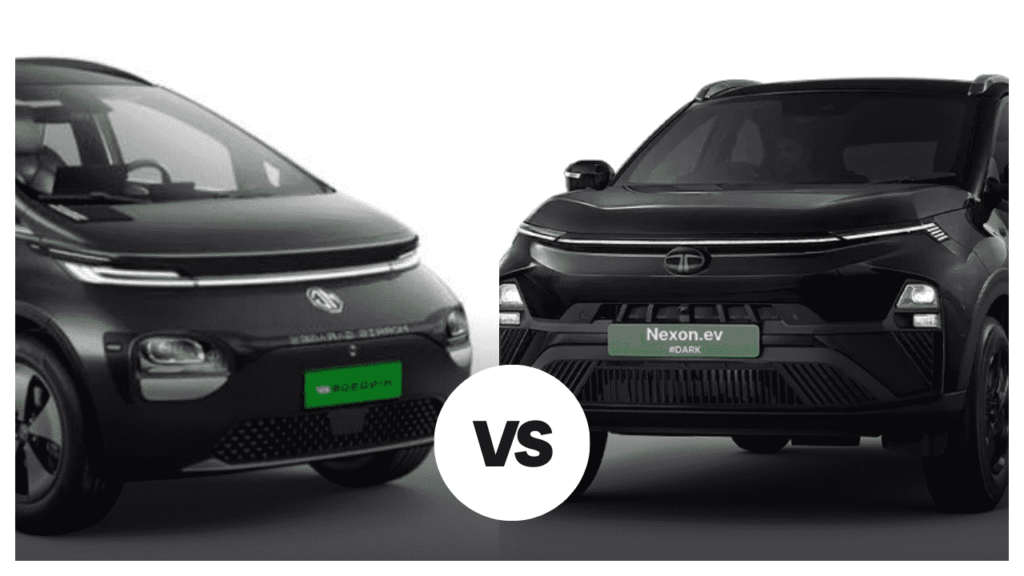
Interior Space
MG Windsor EV: The Windsor EV offers a spacious and luxurious interior with ample legroom and headroom. The premium upholstery and finishing provide a refined experience.
Tata Nexon EV: While smaller in size, the Nexon EV’s interior is practical and well-designed, offering comfortable seating for five passengers, though it doesn’t match the luxury level of the MG Windsor.
Driving Experience
MG Windsor EV: Offers a refined driving experience, especially for long-distance driving. The Windsor EV’s acceleration is smooth, and the low noise levels provide a pleasant driving environment.
Tata Nexon EV: Delivers a more rugged and responsive driving experience, particularly suited for urban commuting and rougher road conditions. The higher ground clearance makes it more versatile for different terrains.
Cargo Capacity
MG Windsor EV: Offers more cargo space (400 liters), which is beneficial for families and long trips.
Tata Nexon EV: Has less boot space (350 liters) but still enough for everyday needs, such as shopping or a weekend getaway.
Suspension and Ride Comfort
MG Windsor EV: Its suspension is tuned for comfort, offering a smooth ride over a variety of surfaces. The handling is refined, making it great for long highway drives.
Tata Nexon EV: The suspension is stiffer to handle rougher roads, giving it an advantage on Indian roads. While not as plush as the Windsor EV, it offers a confident and sturdy ride.
Customer Reviews
MG Windsor EV: Customers generally appreciate the MG Windsor EV for its premium features and luxurious interior. Many reviewers have praised the vehicle for its spacious cabin, advanced infotainment system, and smooth driving experience. The long driving range has also been a big selling point for customers, especially for those who frequently travel long distances. Some customers have reported concerns about the availability of charging stations in less urban areas, but this is improving as MG expands its EV infrastructure.
Tata Nexon EV: Customer reviews of the Tata Nexon EV emphasize its affordability, practicality, and good overall performance in Indian driving conditions. Many users appreciate its rugged build, high ground clearance, and ease of driving in city traffic. The Tata Nexon EV has also been well-received for its fast-charging capabilities, making it a practical choice for urban dwellers. However, some users have mentioned that the range could be improved for longer journeys.
Advantages and Disadvantages
MG Windsor EV Advantages
1. Premium Features: The MG Windsor EV is packed with advanced features, including a larger touchscreen infotainment system, adaptive cruise control, automatic climate control, and more, offering a luxury feel.
2. Longer Range: It has a superior range, which makes it ideal for long trips without frequent recharging.
3. High-Tech Safety Features: The inclusion of ADAS (Advanced Driver Assistance Systems) like lane-keeping assist, collision warnings, and autonomous emergency braking enhances safety.
4. Bigger Boot Space: Its 400-liter boot space allows for more storage, which is convenient for families or long road trips.
5. Better NVH Levels: The Windsor EV has lower noise, vibration, and harshness levels, providing a quieter and more refined driving experience.
6. Customizable Regenerative Braking: The adjustable levels of regenerative braking give drivers better control over energy usage and vehicle dynamics.
7. Luxurious Interior: It offers more premium materials and an aesthetically pleasing design inside the cabin.
MG Windsor EV Disadvantages
1. Higher Price: The Windsor EV comes at a steeper price point, which might not be suitable for budget-conscious buyers.
2. Lower Ground Clearance: Its 180 mm ground clearance is slightly lower, making it less capable on rough roads compared to the Nexon EV.
3. Limited Charging Infrastructure: While growing, MG’s EV service and charging network isn’t as widespread as Tata’s in India.
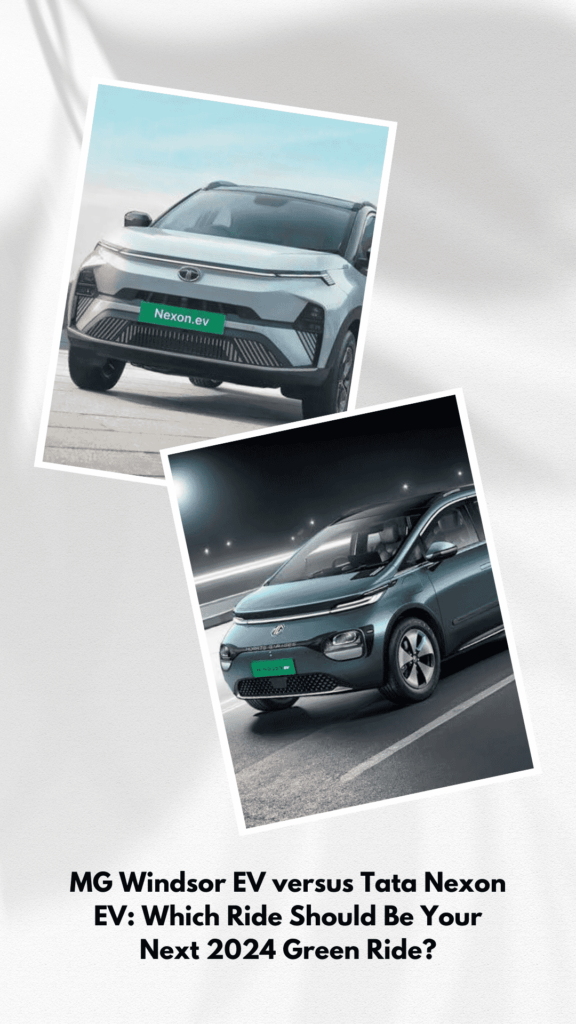
Tata Nexon EV Advantages
1. Affordability: With its relatively lower starting price, the Nexon EV offers great value for first-time electric vehicle buyers.
2. High Ground Clearance: Its 205 mm ground clearance ensures better performance on uneven and challenging road conditions.
3. Wide Service Network: Tata Motors has a more established service and charging infrastructure across India, providing convenience for EV owners.
4. Compact Design for Urban Driving: Its smaller size makes it easy to navigate through city traffic, ideal for urban commuting.
5. Multiple Driving Modes: It comes with three driving modes, allowing you to adjust for performance or range, depending on your driving conditions.
6. Long Warranty Coverage: Tata offers comprehensive warranty options on the battery and motor, ensuring peace of mind for the long-term ownership experience.
Tata Nexon EV Disadvantages
1. Less Range: The Nexon EV’s range is shorter compared to its competitors like the Windsor EV, requiring more frequent recharging.
2. Fewer High-Tech Features: While it offers solid basics, it lacks some of the more advanced tech features and luxury touches found in the Windsor EV.
3. No Adjustable Regenerative Braking: The Nexon EV has a single, non-adjustable regenerative braking system, giving drivers less control over energy recovery.
Conclusion
The choice between the MG Windsor EV and the Tata Nexon EV largely depends on your priorities as a buyer. If you are looking for a premium experience, packed with cutting-edge features, a luxurious cabin, and a longer range for highway travel, the MG Windsor EV is your go-to option. It appeals to buyers who want a more comfortable and tech-forward experience and are willing to invest more in their EV.
On the other hand, if you are seeking affordability, robust performance on Indian roads, and a well-rounded urban commuting experience, the Tata Nexon EV is an excellent choice. It stands out for its value for money, practicality, and Tata’s well-established after-sales network.
Ultimately, both EVs play their part in promoting a greener future. Choosing between them boils down to whether you prioritize budget and rugged performance (Nexon EV) or luxury and advanced features (Windsor EV).
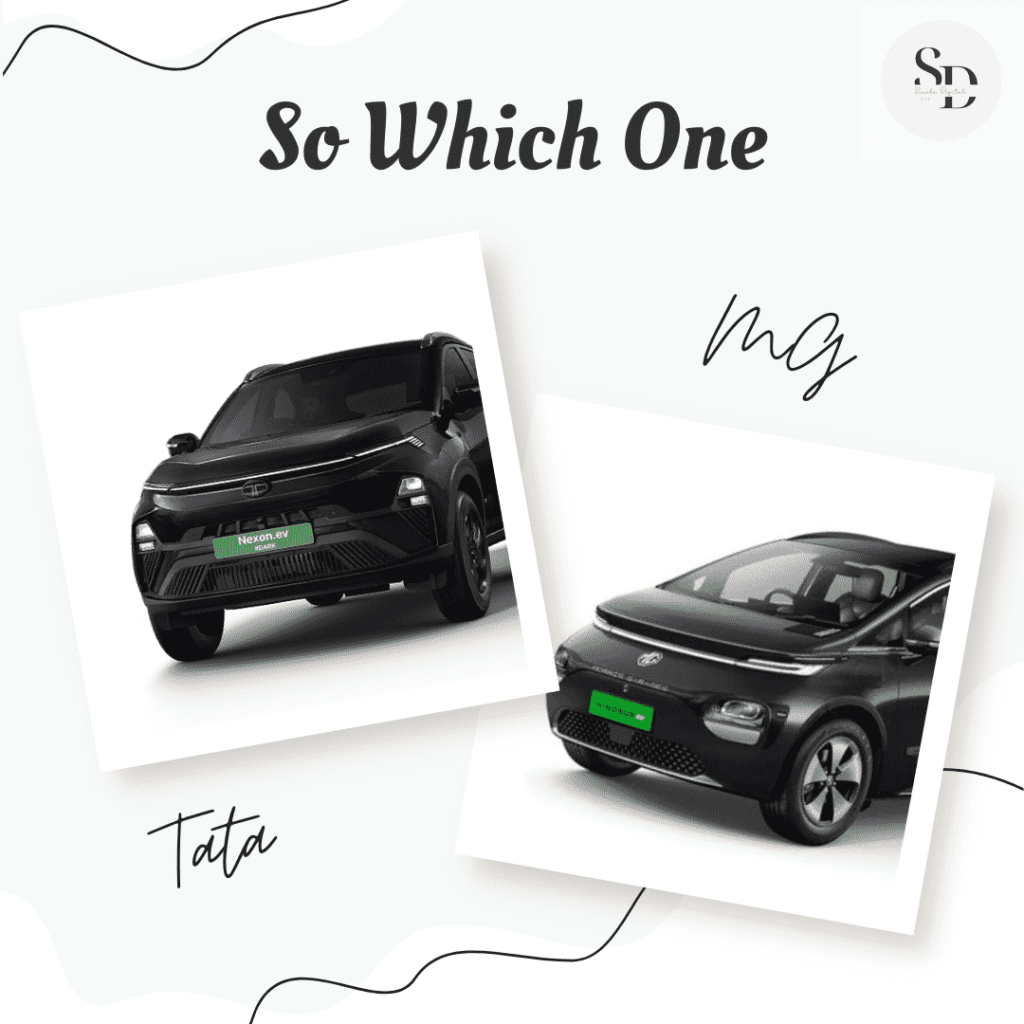
Thank You Note
Thank you for reading this comprehensive comparison of the MG Windsor EV and the Tata Nexon EV. We hope this detailed guide helps you make an informed decision on your next green vehicle. Stay tuned for more insights and updates on the latest trends in electric vehicles and sustainable transportation. If you have any questions or suggestions, feel free to leave a comment or contact us directly.
Frequently Asked Questions
How do customer reviews rate the driving experience of these vehicles?
What are the resale values like for both vehicles?
What is the price range for both vehicles?
What is the warranty period for the battery in both models?
How do the infotainment systems compare between the two vehicles?
What are the key safety features available in both vehicles?
What is the driving range of the MG Windsor EV compared to the Tata Nexon EV?
Bonus Read
Origin of the Companies
Tata Motors
Tata Motors is a subsidiary of the Indian conglomerate Tata Group, one of India’s largest and oldest business groups. Established in 1945, Tata Motors initially focused on manufacturing locomotives before transitioning into the automotive sector. Over the decades, Tata Motors has grown into a global automotive player, recognized for producing both passenger and commercial vehicles. Today, Tata Motors is at the forefront of India’s electric vehicle revolution, having launched several EV models, including the Nexon EV, which have contributed to the country’s growing focus on sustainable mobility.
MG Motor
MG Motor (Morris Garages) was originally founded in the UK in the 1920s, known for producing affordable sports cars. The brand evolved over the decades but faced various ownership changes until it was acquired by China’s SAIC Motor Corporation in 2007. Since then, MG has re-entered global markets, focusing heavily on electric vehicles and modernizing its brand for the 21st century. Under SAIC’s leadership, MG has expanded its presence, especially in countries like India, where the Windsor EV represents the brand’s commitment to offering high-tech, eco-friendly vehicles with a premium touch.
Disclaimer
The information provided in this article is based on publicly available data and our own research as of 2024. Prices, features, and specifications may vary based on location, dealership, or ongoing updates from manufacturers. We recommend consulting with official dealers for the most accurate and up-to-date information before making a purchase decision. The content provided is for informational purposes only and does not constitute any formal or legal advice.
Also the advantages and disadvantages discussed in this article are intended solely for informational purposes and are not meant to defame, harm, or discredit any brand or vehicle manufacturer. The comparisons have been made objectively, based on publicly available data and user experiences as of 2024. We encourage potential buyers to consider their personal needs and conduct further research before making a purchase decision. All information provided is accurate to the best of our knowledge, but features, prices, and specifications may vary. Always consult with official dealers for the most up-to-date information.
For more exciting topics, explore our other articles here
Tata Punch vs Mahindra XUV300 – Which One Comes Out on Top?
Affordable 1 vs. Premium 1: Hero Cycles vs. Firefox Bikes – Which Wins?
Marshall vs JBL: Classic Style Meets Modern Innovation – Who Comes Out on Top in 2024?
Mercedes-Benz C-Class vs BMW 3 Series: Which Executive Sedan Dominates 2024?
Water for Kings: Bisleri vs Kinley – Unveiling the Pharaoh’s Choice
10 Facts You Should Know: Whiskey vs. Rum Showdown
One Comment